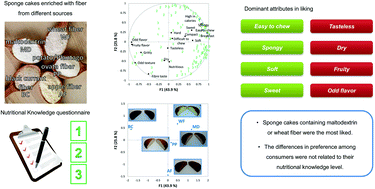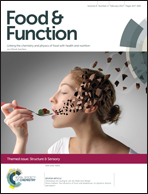Importance of consumer perceptions in fiber-enriched food products. A case study with sponge cakes†
Abstract
Sponge cakes enriched with fiber from different sources (maltodextrin, wheat, apple, blackcurrant and a mixture of potato and Plantago ovata) were studied. Profiling of the different cakes was carried out, first using a check-all-that-apply (CATA) question then evaluating the consumers’ likings using a hedonic scale. The consumers also completed a nutrition knowledge (NK) questionnaire that was used to classify them according to their NK level. The instrumental texture of the cakes was evaluated by the texture profile analysis (TPA) method. The consumers’ response was not linked to their NK level, but it mainly depended on the importance they gave to the cakes’ distinctive sensory characteristics. In general, liking increased for samples considered easy to chew, spongy, soft and sweet, and decreased for samples perceived as tasteless, dry or having a fruity or an odd flavor. The sponge cakes containing maltodextrin or wheat fiber, which mostly resembled a conventional cake, were the most liked in general. Those containing the other three fibers were rejected by part of the consumers, for being tasteless in the case of potato plus Plantago ovata fiber, for being dry and doughy in the case of apple fiber and for having an odd flavor in the case of blackcurrant fiber.

- This article is part of the themed collection: Structure & Sensory

 Please wait while we load your content...
Please wait while we load your content...